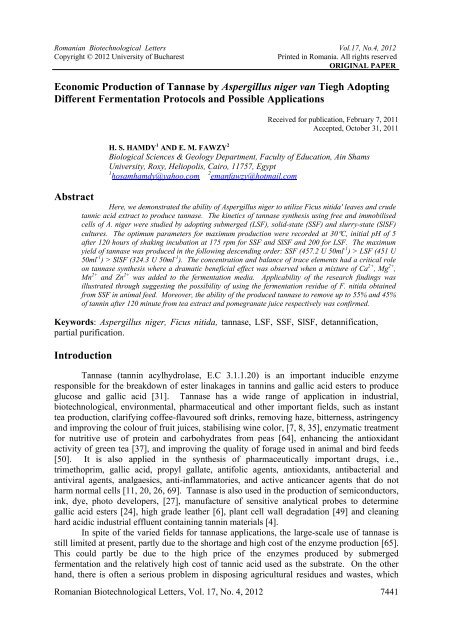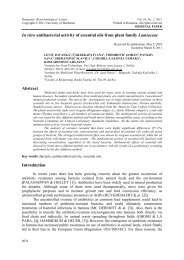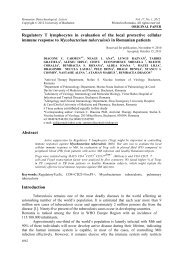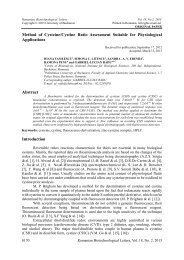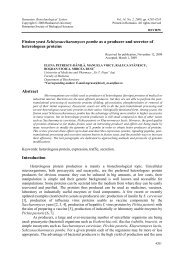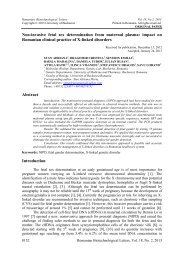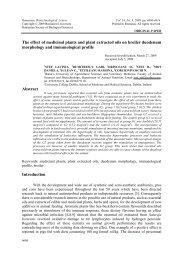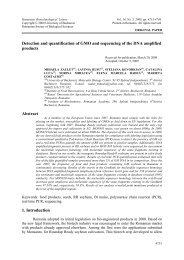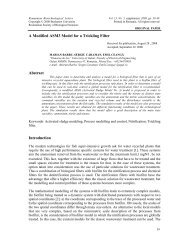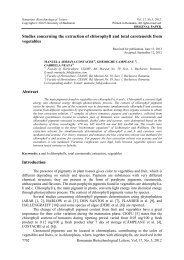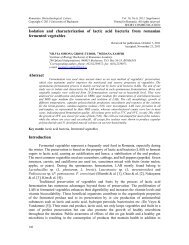Economic Production of Tannase by Aspergillus niger ... - Rombio.eu
Economic Production of Tannase by Aspergillus niger ... - Rombio.eu
Economic Production of Tannase by Aspergillus niger ... - Rombio.eu
Create successful ePaper yourself
Turn your PDF publications into a flip-book with our unique Google optimized e-Paper software.
Romanian Biotechnological Letters Vol.17, No.4, 2012<br />
Copyright © 2012 University <strong>of</strong> Bucharest Printed in Romania. All rights reserved<br />
ORIGINAL PAPER<br />
<strong>Economic</strong> <strong>Production</strong> <strong>of</strong> <strong>Tannase</strong> <strong>by</strong> <strong>Aspergillus</strong> <strong>niger</strong> van Tiegh Adopting<br />
Different Fermentation Protocols and Possible Applications<br />
Abstract<br />
Romanian Biotechnological Letters, Vol. 17, No. 4, 2012<br />
Received for publication, February 7, 2011<br />
Accepted, October 31, 2011<br />
H. S. HAMDY 1 AND E. M. FAWZY 2<br />
Biological Sciences & Geology Department, Faculty <strong>of</strong> Education, Ain Shams<br />
University, Roxy, Heliopolis, Cairo, 11757, Egypt<br />
1 hosamhamdy@yahoo.com 2 emanfawzy@hotmail.com<br />
Here, we demonstrated the ability <strong>of</strong> <strong>Aspergillus</strong> <strong>niger</strong> to utilize Ficus nitida' leaves and crude<br />
tannic acid extract to produce tannase. The kinetics <strong>of</strong> tannase synthesis using free and immobilised<br />
cells <strong>of</strong> A. <strong>niger</strong> were studied <strong>by</strong> adopting submerged (LSF), solid-state (SSF) and slurry-state (SlSF)<br />
cultures. The optimum parameters for maximum production were recorded at 30°C, initial pH <strong>of</strong> 5<br />
after 120 hours <strong>of</strong> shaking incubation at 175 rpm for SSF and SlSF and 200 for LSF. The maximum<br />
yield <strong>of</strong> tannase was produced in the following descending order: SSF (457.2 U 50ml -1 ) > LSF (451 U<br />
50ml -1 ) > SlSF (324.3 U 50ml -1 ). The concentration and balance <strong>of</strong> trace elements had a critical role<br />
on tannase synthesis where a dramatic beneficial effect was observed when a mixture <strong>of</strong> Ca 2+ , Mg 2+ ,<br />
Mn 2+ and Zn 2+ was added to the fermentation media. Applicability <strong>of</strong> the research findings was<br />
illustrated through suggesting the possibility <strong>of</strong> using the fermentation residue <strong>of</strong> F. nitida obtained<br />
from SSF in animal feed. Moreover, the ability <strong>of</strong> the produced tannase to remove up to 55% and 45%<br />
<strong>of</strong> tannin after 120 minute from tea extract and pomegranate juice respectively was confirmed.<br />
Keywords: <strong>Aspergillus</strong> <strong>niger</strong>, Ficus nitida, tannase, LSF, SSF, SlSF, detannification,<br />
partial purification.<br />
Introduction<br />
<strong>Tannase</strong> (tannin acylhydrolase, E.C 3.1.1.20) is an important inducible enzyme<br />
responsible for the breakdown <strong>of</strong> ester linakages in tannins and gallic acid esters to produce<br />
glucose and gallic acid [31]. <strong>Tannase</strong> has a wide range <strong>of</strong> application in industrial,<br />
biotechnological, environmental, pharmac<strong>eu</strong>tical and other important fields, such as instant<br />
tea production, clarifying c<strong>of</strong>fee-flavoured s<strong>of</strong>t drinks, removing haze, bitterness, astringency<br />
and improving the colour <strong>of</strong> fruit juices, stabilising wine color, [7, 8, 35], enzymatic treatment<br />
for nutritive use <strong>of</strong> protein and carbohydrates from peas [64], enhancing the antioxidant<br />
activity <strong>of</strong> green tea [37], and improving the quality <strong>of</strong> forage used in animal and bird feeds<br />
[50]. It is also applied in the synthesis <strong>of</strong> pharmac<strong>eu</strong>tically important drugs, i.e.,<br />
trimethoprim, gallic acid, propyl gallate, antifolic agents, antioxidants, antibacterial and<br />
antiviral agents, analgaesics, anti-inflammatories, and active anticancer agents that do not<br />
harm normal cells [11, 20, 26, 69]. <strong>Tannase</strong> is also used in the production <strong>of</strong> semiconductors,<br />
ink, dye, photo developers, [27], manufacture <strong>of</strong> sensitive analytical probes to determine<br />
gallic acid esters [24], high grade leather [6], plant cell wall degradation [49] and cleaning<br />
hard acidic industrial effluent containing tannin materials [4].<br />
In spite <strong>of</strong> the varied fields for tannase applications, the large-scale use <strong>of</strong> tannase is<br />
still limited at present, partly due to the shortage and high cost <strong>of</strong> the enzyme production [65].<br />
This could partly be due to the high price <strong>of</strong> the enzymes produced <strong>by</strong> submerged<br />
fermentation and the relatively high cost <strong>of</strong> tannic acid used as the substrate. On the other<br />
hand, there is <strong>of</strong>ten a serious problem in disposing agricultural residues and wastes, which<br />
7441
H. S. HAMDY AND E. M. FAWZY<br />
may cause serious environmental contamination and propagation <strong>of</strong> flies and rats if not<br />
correctly dealt with. Meanwhile, agricultural wastes can represent large renewable resources<br />
for enzyme production <strong>by</strong> filamentous fungi and has been practiced worldwide as waste-based<br />
cultures adopting solid state fermentation [67]. To bridge this gap, alternative techniques<br />
such as solid/slurry state fermentations, use <strong>of</strong> whole-cell-immobilization, and/or use <strong>of</strong> less<br />
expensive substrates such as agricultural residues may be used in obtaining relevant costeffective<br />
products such as enzymes and forage among others. In Egypt, Ficus nitida L.<br />
(Moraceae) is a widely cultivated ornamental plant that annually yields a vast amount <strong>of</strong> waste<br />
in the form <strong>of</strong> leaves. Although Ficus wastes are highly nutritious for microorganisms [29],<br />
there is still no study that examines its potential use as a bioresource for tannase production.<br />
Solid state fermentation (SSF) is a batch process used for its many advantages such as<br />
the low cost <strong>of</strong> raw materials, simple equipments and facilities, labour and technology.<br />
Moreover, the secreted enzymes in the culture filtrate are more concentrated and <strong>of</strong> higher<br />
quality, with a less effluent generated and lower a lower cost <strong>of</strong> recovery than in the liquid<br />
state cultures [43]. It is also a natural environment that provides easy aeration, high surface<br />
exchange and serves as a support for the cells [44]. Along with the SSF, there is a growing<br />
interest in the whole-immobilized cells to produce enzymes as a promising technique<br />
proposed for improving the fermentation process where it <strong>of</strong>fers several advantages, i.e., easy<br />
to handle, r<strong>eu</strong>sable, continuous operation over a prolonged period with operational stability,<br />
reducing the overall cost and delays associated with the time needed for sterilisation,<br />
inoculation and mycelium growth, lower susceptibility to microbial contamination, lower<br />
vulnerability to inhibitory compounds and nutrient depletion, and increased rates <strong>of</strong><br />
generating <strong>of</strong> microbial products [17, 51]. Meanwhile, very little information can be found in<br />
the literature about slurry state fermentation and their applications are mostly restricted to<br />
anaerobic fermentations [18].<br />
Many fungal species have been reported to produce tannase, including <strong>Aspergillus</strong><br />
aculeatus, A. aur<strong>eu</strong>s, A. flavus, A. foetidus, A. japonicas, A. <strong>niger</strong>, A. oryzae Aureobasidium<br />
pullulans, Fusarium solani F. subglutinans, Paecilomyces variotii, Penicillium<br />
atramentosum; P.chrysogenum, P. variable, and R. oryzae as reviewed <strong>by</strong> Belur and<br />
Mugeraya [10] and Chavez-Gonzalez [16]. The vast majority produce in submerged cultures,<br />
while <strong>Aspergillus</strong> and Penicillium are the most active microorganisms capable <strong>of</strong> producing<br />
tannase through both submerged and solid state fermentations [45, 46]. Different agricultural<br />
residues such as cassava, carob bean, wine-grape, tea and c<strong>of</strong>fee wastes, [65]; Acacia nilotica,<br />
A. auriculiformis, Casuarina equisetifolia, Cassia fistula, Ficus benghalensis, [39] and<br />
gobernadora [62], have been associated with microbial production <strong>of</strong> tannase on SSF, while<br />
many studies have investigated tannase production with pure tannic acid as the soul carbon<br />
source [39].<br />
Thus, the aim <strong>of</strong> this study was to investigate, compare and optimise production <strong>of</strong><br />
tannase utilising crude tannic acid extract and leaves <strong>of</strong> F. nitida adopting LSF, SSF and SlSF<br />
protocols inoculated with free and immobilised cells <strong>of</strong> A. <strong>niger</strong>. Possible applications <strong>of</strong> the<br />
produced tannase as well as the fermentation residue are also suggested.<br />
Materials and Methods<br />
Preparation <strong>of</strong> materials and equipments<br />
Plant leaves were collected in May from mature trees <strong>of</strong> Ficus nitida, cultivated in<br />
different Egyptian localities, cut into small pieces, and then oven-dried at 55°C for 24 h until<br />
they reached a constant weight. The material was then finely ground to pass through a 50μm<br />
sieve. The powder was stored in dry flasks under dark conditions at room temperature.<br />
7442 Romanian Biotechnological Letters, Vol. 17, No. 4, 2012
<strong>Economic</strong> <strong>Production</strong> <strong>of</strong> <strong>Tannase</strong> <strong>by</strong> <strong>Aspergillus</strong> <strong>niger</strong> van Tiegh<br />
Adopting Different Fermentation Protocols and Possible Applications<br />
Crude tannin extract was prepared according to the method <strong>of</strong> Schanderi [55] where<br />
50 g <strong>of</strong> dry plant materials were mixed with 200 ml <strong>of</strong> distilled water and kept at room<br />
temperature overnight. After soaking, the mixture was boiled for 10 min and filtered. The<br />
filtrate served as a crude tannin extract from which different dilutions were prepared using<br />
distilled water.<br />
Cleaning <strong>of</strong> equipments used in studying the requirements <strong>of</strong> metallic nutrition was<br />
performed <strong>by</strong> washing in hot detergent solution, rinsing in tap water, drying and submerging<br />
in a bath <strong>of</strong> hot, concentrated nitric-sulphuric acid (2:1) for 15 minutes. The glassware was<br />
removed from this bath and rinsed 5 times with distilled water and finally 2 times with glassdistilled<br />
water.<br />
Microorganism<br />
<strong>Aspergillus</strong> <strong>niger</strong> van Tiegh CBC 122722 used throughout this work was previously<br />
isolated from an Egyptian soil sample, identified <strong>by</strong> the CBS-KNAW (Fungal Biodiversity<br />
Centre, Uppsalalaan, Netherlands) and kept on malt extract agar at 4 °C and routinely<br />
cultured.<br />
Spore suspension (containing about 2 x 10 6 spores ml -1 ) was freshly prepared from 7day-old<br />
cultures <strong>of</strong> A. <strong>niger</strong> grown on malt extract agar slants at 30°C using deionised double<br />
distilled water.<br />
Entrapped spores <strong>of</strong> A. <strong>niger</strong> was prepared according to the method described <strong>by</strong><br />
Yalcinkaya [71] where 10 ml <strong>of</strong> 5% Na-alginate was mixed with 1 ml <strong>of</strong> the fungal spore<br />
suspension. The mixture was introduced into a solution containing 0.1 M CaCl2 with a<br />
syringe with a constant stirring to prevent aggregation <strong>of</strong> the beads. The fungal sporeentrapped<br />
beads (about 2.5 mm in diameter to overcome the anaerobic conditions inside the<br />
large beads [60]) were cured in this solution for 1 h and then washed twice with 200 ml <strong>of</strong><br />
sterile distilled water. The beads with immobilised spores (about 20 ml volume) were then<br />
transferred to the fermentation medium.<br />
Screening<br />
The potential <strong>of</strong> different fungal strains for tannase production was screened in tannic<br />
acid medium composed <strong>of</strong> (g/l): freshly prepared filter-sterilised tannic acid (30g), (NH4)2SO4<br />
(2g), KH2PO4 (0.5g), MgSO4 (2g), and agar agar (30g) [4]. The tannase-producing organisms<br />
were grown according to one <strong>of</strong> the following fermentation protocols.<br />
Enzyme production and fermentation media<br />
(A) Batch cultures<br />
Flasks containing one <strong>of</strong> the following fermentation media were prepared in<br />
triplicates, the initial pH value adjusted to 5.5, and incubated for 96 h at 30°C under static and<br />
shaking conditions (GFL shaking incubator, 150 rpm).<br />
Liquid state fermentation (LSF) medium<br />
Liquid state fermentation (LSF) medium was composed <strong>of</strong> (g/l): freshly prepared<br />
filter-sterilised crude tannin extract (30g), (NH4)2SO4 (2.0g), K2HPO4 (0.5g) and<br />
MgSO4.7H2O (1.0g) in a final volume <strong>of</strong> 50 ml per flask [4]. Medium was inoculated with 1<br />
ml <strong>of</strong> free A. <strong>niger</strong> spore suspension, or with about 20 ml <strong>of</strong> immobilised cells.<br />
Solid state fermentation (SSF)<br />
Five ml <strong>of</strong> LSF medium without any <strong>of</strong> the carbon (crude tannin extract) and nitrogen<br />
((NH4)2SO4) sources were added to 10 g <strong>of</strong> powdered Ficus nitida leaves and inoculated with<br />
1 ml <strong>of</strong> free spore suspension.<br />
Romanian Biotechnological Letters, Vol. 17, No. 4, 2012 7443
H. S. HAMDY AND E. M. FAWZY<br />
Slurry state fermentation (SlSF)<br />
Similar sets <strong>of</strong> flasks used in SSF were prepared, while an extra amount <strong>of</strong> 45 ml <strong>of</strong><br />
distilled water was added to the medium to set the slurry state condition (SlSF) and then were<br />
inoculated with 1 ml <strong>of</strong> free spore suspension.<br />
(B) Repeated batch cultures<br />
Flasks (LSF) inoculated with immobilised spores were incubated for 120 hours at the<br />
first cycle to allow the mycelium to develop and then the duration <strong>of</strong> each cycle was 48 hour.<br />
At the end <strong>of</strong> each run the beads were aseptically filtered, washed thoroughly with 25 ml<br />
saline, acetate buffer (0.2 M, pH 5) and distilled water and then recultivated into 50 ml<br />
aliquots <strong>of</strong> fresh medium.<br />
Enzyme extraction<br />
At the end <strong>of</strong> incubation, the cell-free filtrate in LSF was obtained <strong>by</strong> filtering through<br />
Whatman No. 1 filter paper in a Buchner funnel. In SSF and SlSF, a suitable amount <strong>of</strong> the<br />
fermented matter was thoroughly mixed with 10 ml <strong>of</strong> cold distilled water <strong>by</strong> keeping the<br />
flasks on a rotary shaker for 1 h at 200 rpm. The mixture was filtered through muslin cloth<br />
and the filtrate was centrifuged at 10000 rpm for 20 min at 4°C and served as crude enzyme<br />
preparation. The volume <strong>of</strong> all the enzyme extracts obtained from the different protocols was<br />
restored to 50 ml <strong>by</strong> cold distilled water and served as the crude enzyme preparation.<br />
<strong>Tannase</strong> and protein assays<br />
The activity <strong>of</strong> tannase was estimated according to the method <strong>of</strong> Mondal [41] where<br />
0.5 ml <strong>of</strong> enzyme solution was incubated with 3 ml <strong>of</strong> 1.0% (w/v) tannic acid, in 0.2 M acetate<br />
buffer (pH 5.0) at 40 °C for 30 min. The reaction was terminated <strong>by</strong> transferring the tubes<br />
containing the reaction mixture to an ice bath followed <strong>by</strong> the addition <strong>of</strong> 2.0 ml (1%, w/v) <strong>of</strong><br />
bovine serum albumin to precipitate the remaining tannic acid. The precipitate was collected <strong>by</strong><br />
centrifugation (12 x 10 3 g for 15 min) and dissolved in 2 ml sodium dodecyl sulphate (SDS)triethanolamine<br />
(1.0%, w/v, SDS in 5% v/v, triethanolamine) solution. Absorbency was<br />
measured at 550 nm 15 min after the addition <strong>of</strong> 1.0 ml <strong>of</strong> FeCl3 (0.13 M dissolved in 0.01 N<br />
HCl). Control treatments were performed using heat-killed enzyme. One unit <strong>of</strong> tannase is the<br />
amount <strong>of</strong> enzyme capable <strong>of</strong> hydrolysing 1.0 mM min -1 <strong>of</strong> tannic acid under the assay<br />
conditions <strong>by</strong> reference to a standard curve constructed with pure tannic acid [41].<br />
Protein content was determined using bovine serum albumin dissolved in 0.17 M<br />
NaCl as a standard [14].<br />
Chemical analyses<br />
Cellulose, hemicellulose and pectin contents <strong>of</strong> F. nitida' leaves were analysed as<br />
described <strong>by</strong> Jermyn [25] and the total nitrogen was estimated <strong>by</strong> the conventional micro-<br />
Kjeldahl method [33, 48].<br />
Tannin was extracted as described <strong>by</strong> Schanderi [55] and estimated as described <strong>by</strong><br />
Lokeswari [35] adopting the Folin–Denis method where a 50 ml aliquot <strong>of</strong> tannin-containing<br />
solution was mixed with 5 ml <strong>of</strong> Folin–Denis reagent, and then 10 ml <strong>of</strong> 15% (w/v) Na2CO3<br />
solution was added and then diluted to the 100 ml mark with distilled water. After thorough<br />
mixing, the flasks were kept in the dark for 30 minutes at 25°C. The absorbency <strong>of</strong> tannin was<br />
measured spectrophotometrically at 700 nm and its concentration calculated using pure tannic<br />
acid as a standard. Distilled water was used as blank regarding the calibration curve. From<br />
this curve, the concentrations for each sample was obtained and used for the tannin content<br />
calculation.<br />
7444 Romanian Biotechnological Letters, Vol. 17, No. 4, 2012
<strong>Economic</strong> <strong>Production</strong> <strong>of</strong> <strong>Tannase</strong> <strong>by</strong> <strong>Aspergillus</strong> <strong>niger</strong> van Tiegh<br />
Adopting Different Fermentation Protocols and Possible Applications<br />
Optimising process parameters for tannase production<br />
Optimising tannase biosynthesis was performed <strong>by</strong> optimizing various physicochemical<br />
process parameters where the optimum condition found for each parameter was<br />
settled for the subsequent experiments. The effect <strong>of</strong> incubation temperature (25 to 45°C) for<br />
different incubation periods (96 to 168 h) at different agitation speeds (125 to 225 rpm) was<br />
explored. Initial pH value <strong>of</strong> the fermentation medium (4 to 7) was adjusted <strong>by</strong> 0.1 M HCl or<br />
NaOH. The effect <strong>of</strong> various initial tannic acid concentrations (2 to 9 g %, w/v) and the<br />
addition <strong>of</strong> various mineral salts i.e. Mg, Ba, Ca, Co, Fe, K, Mn, Na and Zn (added as<br />
chlorides), were also optimised.<br />
Partial purification <strong>of</strong> tannase<br />
Partially purified tannase was prepared as previously described <strong>by</strong> Hamdy [23] where<br />
protein content <strong>of</strong> 500 ml <strong>of</strong> crude tannase <strong>of</strong> A. <strong>niger</strong> was precipitated overnight with 65%<br />
ammonium sulphate, collected <strong>by</strong> centrifugation at 12,000 ×g for 15 min, desalted <strong>by</strong> passing<br />
through a column <strong>of</strong> Sephadex G-25 and then fractionated <strong>by</strong> applying 2 ml to a column<br />
(2.5×82 cm) <strong>of</strong> diethylaminoethyl cellulose (DEAE cellulose, fast flow, fibrous form, Sigma<br />
Chemicals, Germany) for ion-exchange chromatography. 5 ml fractions were eluted with a<br />
linearly increasing molarity <strong>of</strong> NaCl solution (0.0 to 0.5 M) prepared in 0.2-M acetate buffer,<br />
pH 5.0. <strong>Tannase</strong> activity and the protein content <strong>of</strong> each fraction were determined and used to<br />
calculate the corresponding specific activities. Fractions possessing the highest specific<br />
activities were pooled, desalted, lyophilised and used as partially purified tannase in the<br />
experiments <strong>of</strong> reducing tannin.<br />
Application <strong>of</strong> tannase in reducing tannin from tea extract and pomegranate juice<br />
50 g <strong>of</strong> fresh pomegranate seeds were washed with distilled water and extracted in 100<br />
ml distilled water using an electric blender. The extract was filtered through muslin cloth and<br />
kept cooled at 4°C.<br />
Tea extract was prepared <strong>by</strong> adding 2 g <strong>of</strong> locally purchased black tea leaves to 100 ml<br />
<strong>of</strong> boiled distilled water, left to stand for 20 minutes and then kept cold at 4°C.<br />
15 ml <strong>of</strong> the tea or pomegranate juice was incubated with 1 ml <strong>of</strong> partially purified<br />
tannase containing 17.32 U/ mg protein at 30°C for different incubation periods (30 to 150<br />
min) under shaking conditions (150 rpm). Tannin content was determined pre and post<br />
incubation with the enzyme.<br />
Statistical validation <strong>of</strong> treatment effects<br />
The mean, standard deviation, Tukey's test “T” and probability "P" values <strong>of</strong> three<br />
replicates <strong>of</strong> the investigated parameters and the control were calculated according to the<br />
mathematical principles described <strong>by</strong> Glantz [21]. Results were considered highly significant,<br />
significant or non-significant where P < 0.01, > 0.01 and < 0.05, and > 0.05, respectively.<br />
Results and Discussion<br />
Cellulose, hemicelluloses, lignin, pectin, tannin, nitrogen and protein contents <strong>of</strong> Ficus<br />
nitida’ leaves used in the fermentation medium were determined and the results are given in<br />
Table 1. It is known that the detected amounts are subject to dramatic changes according to<br />
genotype, age <strong>of</strong> plant and leaves, soil fertility and acidity, growing season and methods <strong>of</strong><br />
extraction, drying and assay [3].<br />
Romanian Biotechnological Letters, Vol. 17, No. 4, 2012 7445
H. S. HAMDY AND E. M. FAWZY<br />
Table 1: Chemical composition <strong>of</strong> Ficus nitida’ leaves.<br />
Chemical composition (%)<br />
Cellulose 1<br />
Hemicellulose 1<br />
Lignin 1<br />
Pectin 1<br />
Tannin 2<br />
Ash<br />
Nitrogen (N) and protein content 3<br />
32.7 21.93 0.71 11.03 15.01 7.5 0.19 0.83 1.02 6.37<br />
Analyses carried out adopting the methods <strong>of</strong> 1 Jermyn, [25] 2 Lokeswari [35], 3 Pirie, [48] and Lexander [33].<br />
<strong>Aspergillus</strong> <strong>niger</strong> was selected in this study for being classified as GRAS (generally<br />
regarded as safe) and is <strong>of</strong>ficially approved in France for enzyme production for the food<br />
industry [6] where some applications <strong>of</strong> tannase, especially in detanification processes, are<br />
accepted <strong>by</strong> partially purified enzymes [12], which requires a safe source <strong>of</strong> enzyme.<br />
Entrapment in alginate was selected in this study for its highest effectiveness factor (i.e. 1.12<br />
= amounts <strong>of</strong> tannase produced <strong>by</strong> immobilized cells / corresponding amounts produced <strong>by</strong><br />
free cells under the same conditions) versus the other investigated methods, i.e., adsorption to<br />
kieselguhr (0.68), covalent bonding to silica gel beads (0.53) and cross-linking with<br />
glutaraldehyde (0.43). Moreover, alginate gel is characterised <strong>by</strong> its high biodegradability,<br />
hydrophilicity, mechanical stability, rigidity, chemical inertness, ability to bind cells firmly<br />
and high loading capacity [71].<br />
<strong>Tannase</strong> production <strong>by</strong> free or immobilized cells <strong>of</strong> A. <strong>niger</strong> under static or shaking<br />
conditions, adopting LSF, SSF or SlSF was monitored at different temperatures (25 to 45°C)<br />
for different incubation periods (96 to 168 h) in a bifacatorial design. It was found that 30°C<br />
enabled maximum tannase biosynthesis in all cases and the results <strong>of</strong> the time course<br />
production at 30°C are graphically represented in Fig. 1. The optimum temperature for<br />
tannase production <strong>by</strong> most fungal species is around 30°C [10], while tannase production <strong>by</strong><br />
Trichoderma viride [35] has been maximally recorded at 45°C. Decrease in tannase<br />
biosynthesis <strong>by</strong> A. <strong>niger</strong> above 30°C is in agreement with other findings, such as the sharp<br />
decrease in tannase production <strong>by</strong> A. oryzae and almost no tannase production was detected at<br />
40°C [32].<br />
The results <strong>of</strong> time course <strong>of</strong> tannase production <strong>by</strong> A. <strong>niger</strong> in LSF (Fig. 1 a), SSF or<br />
SlSF (Fig. 1 b) at 30°C showed that the maximum biosynthesis achieved after 120 h <strong>of</strong><br />
shaking incubation, and 144 h <strong>of</strong> static incubation. <strong>Production</strong> under shaking conditions was<br />
significantly higher than the static one within the same fermentation protocol. The increased<br />
order <strong>of</strong> enzyme production in relation to different fermentation protocols is as per the<br />
following sequence: SSF (81.5 U 50 ml<br />
7446 Romanian Biotechnological Letters, Vol. 17, No. 4, 2012<br />
-1 ) > Immobilised LSF (77.5 U 50 ml -1 ) > SlF (75.5 U<br />
50 ml -1 ) > Free LSF (69.5 U 50 ml -1 ) (Fig. 1). Therefore, the next stage <strong>of</strong> experiments<br />
focused on the first three for their significant level <strong>of</strong> production as well as representing the<br />
various fermentation protocols. It has been previously found that tannase production <strong>by</strong> A.<br />
<strong>niger</strong> on solid substrates is higher than in LSF (2), where tannase in LSF is partially<br />
intracellular and subsequently secreted into the medium during fermentation, while the<br />
enzyme in SSF is completely secreted out <strong>of</strong> the cells [31]. On the other hand, Srivastava and<br />
Kar [59] stated that extracellular tannase <strong>of</strong> A. <strong>niger</strong> was optimally produced in submerged<br />
cultures. Our results (Fig. 1 a) also showed that tannase biosynthesis <strong>by</strong> immobilized cells <strong>of</strong><br />
A. <strong>niger</strong> in either shaking (77.5 U 50ml -1 ) or static (66 U 50 ml -1 ) conditions was significantly<br />
Soluble N<br />
Insoluble N<br />
Total N<br />
Total protein
<strong>Economic</strong> <strong>Production</strong> <strong>of</strong> <strong>Tannase</strong> <strong>by</strong> <strong>Aspergillus</strong> <strong>niger</strong> van Tiegh<br />
Adopting Different Fermentation Protocols and Possible Applications<br />
higher (P < 0.01) than that <strong>by</strong> free cells (69.5 & 52.5 U 50 ml -1 , in order). Higher amounts <strong>of</strong><br />
tannase production <strong>by</strong> immobilised cells <strong>of</strong> A. <strong>niger</strong> and Bacillus licheniformis KBR6<br />
compared to free cells have also been reported [17, 40].<br />
a- LSF<br />
b- SSF and SlSF<br />
Fig. 1. Time course <strong>of</strong> tannase production <strong>by</strong> A. <strong>niger</strong> at different incubation periods adopting (a) liquid state<br />
(LSF), (b) solid state (SSF) and slurry state (SlSF) fermentation protocols using crude tannic acid extract and F.<br />
nitida leaves, respectively.<br />
Cultures were incubated for the indicated incubation periods while pH was initially<br />
Adjusted to 5.5 and the velocity <strong>of</strong> shaking, if applied, was 150 rpm.<br />
The data represent the mean <strong>of</strong> 3 different readings and the error bars represent the standard deviation <strong>of</strong> means.<br />
<strong>Tannase</strong> biosynthesis in LSF <strong>by</strong> A. flavus has been maximally recorded after 96 h<br />
[45]; while in SSF P. atramentosum has been maximally recorded after 96 h [56]; A. <strong>niger</strong><br />
Romanian Biotechnological Letters, Vol. 17, No. 4, 2012 7447
H. S. HAMDY AND E. M. FAWZY<br />
after 96 h [32], A. <strong>niger</strong> [19], and Paecilomyces variotii, [7] after 120 h; and after 144 h for A.<br />
<strong>niger</strong> ATCC 16620, [54]. Comparison <strong>of</strong> the incubation periods should be undertaken<br />
cautiously even for the same fungal species due to the variation in state <strong>of</strong> the fermentation<br />
and substrate utilised. The recorded decreases in tannase biosynthesis with prolonged<br />
incubation (Fig 1 a & b) could be explained <strong>by</strong> substrate scarcity in the medium, a shift in the<br />
reaction equilibrium due to accumulation <strong>of</strong> gallic acid [27] or an accumulation <strong>of</strong> toxic<br />
metabolities in the fermentation medium.<br />
The effect <strong>of</strong> shaking velocity on tannase production <strong>by</strong> A. <strong>niger</strong> was evaluated and<br />
the maximum yield was obtained at 175 rpm for SSF (89.93 U / 50 ml) and SlSF (88.76 U /<br />
50 ml), while 200 rpm was the optimum (86.76 U/50 ml) for LSF inoculated with<br />
immobilized cells (Fig. 2). A concurrent increase in tannase biosynthesis with an increase in<br />
shaking velocity could be due to the enhancement effect <strong>of</strong> shaking on heat, mass and oxygen<br />
transfer capabilities in the fermentation media that minimizes moisture loss and drying in SSF<br />
[27] and overcomes a serious constraint to high enzyme productivity <strong>by</strong> immobilized aerobic<br />
cells where most <strong>of</strong> the interiors <strong>of</strong> large beads may be anaerobic [60]. On the other hand, a<br />
decline in tannase biosynthesis as the velocity <strong>of</strong> shaking increases above the optimum level<br />
could be ascribed to increasing the frequency <strong>of</strong> particle tumbling that disrupts the mycelium<br />
in the early growth stages [36], thus increasing vaculoation <strong>of</strong> older hyphal compartments and<br />
leading to autolysis or weakened hyphae [47] and/or making the mycelium easier to peel <strong>of</strong>f<br />
from the substrate surface [61]. A decrease in enzyme biosynthesis at higher rotation speeds<br />
was more pronounced in SSF and SlSF than in LSF using immobilised cells where the curve<br />
was broader (Fig. 2), most probably, due to the known protective effect <strong>of</strong> the immobilisation<br />
on cells.<br />
Fig. 2. Effect <strong>of</strong> shaking velocity on tannase production <strong>by</strong> A. <strong>niger</strong> after 120 h <strong>of</strong> incubation at 30°C, in the<br />
different fermentation protocols (LSF __ ♦ __ , inoculated with immobilized cells <strong>of</strong> A. <strong>niger</strong>; SSF __ ■ __ and<br />
SlSF __ ▲ __ inoculated with free cells <strong>of</strong> A. <strong>niger</strong> and grown on leaves <strong>of</strong> F. nitida) at the indicated velocity <strong>of</strong><br />
shaking. Initial pH <strong>of</strong> the medium was adjusted to 5.5.<br />
7448 Romanian Biotechnological Letters, Vol. 17, No. 4, 2012
<strong>Economic</strong> <strong>Production</strong> <strong>of</strong> <strong>Tannase</strong> <strong>by</strong> <strong>Aspergillus</strong> <strong>niger</strong> van Tiegh<br />
Adopting Different Fermentation Protocols and Possible Applications<br />
Maximum tannase production <strong>by</strong> A. <strong>niger</strong> (96.11, 114.76, 106.8 U 50 ml -1 for LSF,<br />
SSF, SlSF in order) was optimally recorded at an initial pH <strong>of</strong> 5.0 <strong>of</strong> the fermentation medium<br />
(Fig. 3). Applying different fermentation protocols have so far not been found to shift the<br />
optimum pH value, where a range <strong>of</strong> 4.5 to 6.5 enabled maximum tannase production <strong>by</strong> A.<br />
flavus, A. foetidus, A. japonicus, A. <strong>niger</strong>, A. oryzae, Paecilomyces variotti, Penicillium<br />
atramentosum, P. chrysogenum, grown on tannery solid substrates or in submerged media [1,<br />
6, 7, 27, 50, 56]. It is known that biological surfaces consist <strong>of</strong> different functional groups<br />
that become dissociated if the pH is above a certain value [71]. As shown in Fig. 3, the curve<br />
<strong>of</strong> tannase synthesis in LSF is broader, where a decline in tannase synthesis is lower and the<br />
active pH range is wider than that in SSF and SlSF.<br />
Fig. 3. pH-dependency <strong>of</strong> tannase production <strong>by</strong> A. <strong>niger</strong> after 120 h <strong>of</strong> shaking incubation at 30°C in different<br />
fermentation protocols (LSF __ ♦ __ , 200 rpm, inoculated with immobilised cells <strong>of</strong> A. <strong>niger</strong>;SSF __ ■ __ , and<br />
SlSF __ ▲ __ , 175 rpm, inoculated with free cells <strong>of</strong> A. <strong>niger</strong> and grown on leaves <strong>of</strong> F. nitida). Initial pH <strong>of</strong> the<br />
medium was adjusted using 0.1 M HCl or NaOH.<br />
The effect <strong>of</strong> initial tannin concentration on production <strong>of</strong> tannase <strong>by</strong> A. <strong>niger</strong> was<br />
studied and the results showed that maximum productivity was attained at 7% (w/v) in both<br />
LSF (146.10 U 50 ml -1 ) and SSF (190.50 U 50 ml -1 ) and at 6% in SlSF (153.72 U 50 ml -1 ),<br />
representing an increase in production <strong>of</strong> 1.88, 2.34 and 2.04-fold, respectively (Table 2).<br />
Tannin concentration is an important detrimental factor in microbial production <strong>of</strong> tannase<br />
and its optimum concentration for A. <strong>niger</strong> has been recorded at 4%, 5% and 10% <strong>by</strong> Lekha<br />
and Lonsane [31, 32], Aguilar [2] and Sharma [58], respectively, while various concentrations<br />
ranging from 0.5 to 10% have been recorded for other fungal species [10]. A reduction in the<br />
tannase yield at higher concentrations <strong>of</strong> tannin could be due to its toxic effect where it forms<br />
non-reversible bonds with surface proteins <strong>of</strong> the organism [5], deposition <strong>of</strong> gallic acid on<br />
cell surfaces [57], as well as depriving metal ions and substrates on membranes [13, 52] that<br />
impair metabolism, inhibit the organism and decrease tannase production. The ability <strong>of</strong><br />
several fungi to grow and tolerate relatively high tannin concentrations <strong>of</strong> up to 20%, as in A.<br />
<strong>niger</strong> [22], is an advantage for fungi as tannase producers.<br />
Romanian Biotechnological Letters, Vol. 17, No. 4, 2012 7449
H. S. HAMDY AND E. M. FAWZY<br />
Table 2: The effect <strong>of</strong> varying initial crude tannin concentration on tannase production <strong>by</strong> A. <strong>niger</strong> in different<br />
fermentation protocols.<br />
Crude<br />
<strong>Tannase</strong> productivity<br />
tannin<br />
conc. (%)<br />
*<br />
LSF 1 SSF 2 SlSF 3<br />
U 50 ml -1<br />
% U 50 ml -1<br />
% U 50 ml -1 %<br />
3 (control) 96.11 ± 2.21 100 114.76 * ± 4.36 100 109.80 ± 2.74 100<br />
4 123.00 * ± 3.93 128 161.81 * ± 5.17 141 132.86 * ± 4.51 121<br />
5 131.67 * ± 5.13 137 174.43 * ± 6.27 152 133.95 * ± 4.28 122<br />
6 138.39 * ± 2.90 144 182.47 * ± 4.01 159 153.72 * ± 4.45 140<br />
7 146.10 * ± 6.28 152 190.50 * ± 5.90 166 142.74 * ± 5.42 130<br />
8 143.20 * ± 2.72 149 183.62 * ± 7.52 160 131.76 * ± 5.13 120<br />
9 131.67 * ± 3.42 137 161.81 * ± 4.20 141 117.49 * ± 2.70 107<br />
Initial pH <strong>of</strong> the fermentation medium was adjusted to 5.0, and incubated at 30ºC for 120 h with shacking<br />
incubation at: 200 rpm for LSF and 175 rpm for SSF and SlSF.<br />
1 Liquid state fermentation using crude tannic acid extract and inoculated with immobilised A. <strong>niger</strong> cell.<br />
2 , 3 Solid-state and slurry-state fermentations using F. nitida and inoculated with free cells <strong>of</strong> A. <strong>niger</strong>. 10 g <strong>of</strong><br />
dried F. nitida’ leaves (15% tannin on dry weight base –Table 1- that equals 3% w/v in the fermentation<br />
medium) were used and higher tannin concentrations were applied to the liquid part <strong>of</strong> the medium.<br />
Significance <strong>of</strong> results was statistically validated compared to the control (3% crude tannin concentration)<br />
where * indicates highly significant difference.<br />
The effect <strong>of</strong> adding different metal ions at concentrations <strong>of</strong> 0.1, 0.2 and 0.3 g % (w/v)<br />
to the fermentation media was investigated and the results showed that tannase production<br />
was stimulated in the following descending order: Ca<br />
7450 Romanian Biotechnological Letters, Vol. 17, No. 4, 2012<br />
2+ , Mg 2+ , Mn 2+ , Zn 2+ in LSF and SSF,<br />
and Ca 2+ , Mn 2+ , Mg 2+ , Zn 2+ in SlSF (Table 3). It has been established that metal ions<br />
significantly affect the progress and efficiency <strong>of</strong> fermentation, secretion <strong>of</strong> active enzymes<br />
and synthesis <strong>of</strong> secondary metabolites <strong>by</strong> microorganisms and their ability to attach to their<br />
various substrates [38] <strong>by</strong> affecting the dynamics <strong>of</strong> cell membranes, cell viability,<br />
permeability, membrane fluidity, stability and signalling systems [30]. <strong>Tannase</strong> synthesis <strong>by</strong><br />
A. foetidus, A. japonicas A. <strong>niger</strong> A. oryzae, A. pullulans and R. oryzae are also stimulated <strong>by</strong><br />
Ca 2+ , Mg 2+ , Mn 2+ and Zn 2+ [1, 4, 8, 28, 62], while tannase synthesis <strong>by</strong> A. <strong>niger</strong> [6] and P.<br />
chrysogenum [50] is inhibited <strong>by</strong> Zn +2 . On the other hand, in the present investigation,<br />
tannase synthesis <strong>by</strong> A. <strong>niger</strong> was inhibited in the following descending order: Ba 2+ , Co 2+ ,<br />
Fe 2+ in LSF and Co 2+ , Ba 2+ and Fe 2+ in SSF and SlSF. Ba 2+ and Co 2+ also inhibit tannase<br />
synthesis <strong>by</strong> A. <strong>niger</strong> and A. pullulans [4]. Inhibition mediated <strong>by</strong> Fe 2+ is in agreement with<br />
the results <strong>of</strong> Rajakumar and Nandy [50] and Barthom<strong>eu</strong>f [6] on tannase synthesis <strong>by</strong> A.<br />
<strong>niger</strong>, A. pullulans and P. chrysogenum but disagree with those <strong>of</strong> Banerjee [4] and Trevino-<br />
Cueto [62] on tannase synthesised <strong>by</strong> A. aculeatus and A. <strong>niger</strong>, respectively. The presence <strong>of</strong><br />
some metal ions in the fermentation medium may inhibit tannase synthesis due to their<br />
binding with tannic acid to form insoluble complexes, hence, limiting its bioavailability as a<br />
carbon source and inducer for enzyme synthesis [22]. This assumption was excluded in the<br />
present study where raising the level <strong>of</strong> tannin concentration in the fermentation medium<br />
containing the inhibitory metal salts (i.e. Ba 2+ , Co 2+ , or Fe 2+ ) did not show a significant<br />
enhancement effect on tannase synthesis (P > 0.05, data not shown). On the other hand,<br />
possible inhibition due to the binding <strong>of</strong> tannic acid to metal ions affecting the metal<br />
bioavailability, which in turn affects efficiencies <strong>of</strong> metabolic processes, secretion <strong>of</strong> active<br />
enzymes and the ability <strong>of</strong> the microorganisms to attach to their various substrates [38], was<br />
also ruled out since inhibition <strong>of</strong> tannase synthesis <strong>by</strong> A. <strong>niger</strong> was more pronounced at higher<br />
concentrations <strong>of</strong> Ba 2+ , Co 2+ or Fe 2+ (Table 3). The previous discussion suggests that the<br />
effect <strong>of</strong> metals is, most probably, on the activity <strong>of</strong> the secreted tannase rather than on<br />
tannase synthesis itself, consequently affecting the ability <strong>of</strong> A. <strong>niger</strong> to utilize the available<br />
tannin in the medium. Moreover, reduction in tannase productivity at higher concentrations
<strong>Economic</strong> <strong>Production</strong> <strong>of</strong> <strong>Tannase</strong> <strong>by</strong> <strong>Aspergillus</strong> <strong>niger</strong> van Tiegh<br />
Adopting Different Fermentation Protocols and Possible Applications<br />
<strong>of</strong> metal ions could be due to the partial denaturation <strong>of</strong> some other important enzymes<br />
because <strong>of</strong> the presence <strong>of</strong> excessive free ions in the media [63], nonspecific binding or<br />
aggregation <strong>of</strong> the enzyme [28] or possible osmotic stress on the cells.<br />
Table 3: Effect <strong>of</strong> different metal salts at different concentrations on tannase production <strong>by</strong> A. <strong>niger</strong> in different<br />
fermentation protocols.<br />
Metal<br />
salt<br />
BaCl2<br />
CaCl2<br />
CoCl2<br />
FeCl2<br />
KCl<br />
MnCl<br />
MgCl2<br />
NaCl<br />
ZnCl2<br />
2<br />
Conc.<br />
(g %,<br />
w/v)<br />
<strong>Tannase</strong> productivity (U 50 ml -1 )<br />
LSF 1 SSF 2 SlSF 3<br />
0.1 60.8 ± 2.37 * 167.64 ± 5.69 * 107.60 ± 4.41 *<br />
0.2 53.2 ± 1.17 * 146.68 ± 3.81 * 83.00 ± 2.15 *<br />
0.3 41.04 ± 0.98 * 131.44 ± 4.86 * 56.87 ± 1.42 *<br />
0.1 296.4 ± 9.18 * 321.94 ± 13.19 * 265.93 ± 9.04 *<br />
0.2 278.16 ± 5.28 * 280.03 ± 8.68 * 232.11 ± 7.42 *<br />
0.3 264.48 ± 11.37 * 253.36 ± 7.34 * 222.89 ± 6.46 *<br />
0.1 136.8 ± 3.83 * 62.865 ± 2.01 * 75.32 ± 2.86 *<br />
0.2 63.84 ± 2.17 * 59.05 ± 2.24 * 58.41 ± 2.27 *<br />
0.3 57.76 ± 2.02 * 36.19 ± 0.83 * 39.96 ± 0.91 *<br />
0.1 141.36 ± 4.09 * 173.35 ± 5.37 * 115.29 ± 3.22 *<br />
0.2 133.76 ± 4.14 * 152.4 ± 5.18 * 107.60 ± 4.19 *<br />
0.3 110.96 ± 4.32 * 133.35 ± 4.26 * 93.77 ± 3.46 *<br />
0.1 151.24 ± 5.44 n 190.5 ± 5.52 n 152.18 ± 5.02 n<br />
0.2 152 ± 4.25 n 192.40 ± 7.50 n 158.33 ± 3.64 n<br />
0.3 155.04 ± 3.25 n 203.84 ± 7.94 156.79 ± 3.29 n<br />
0.1 121.6 ± 4.37 * 169.54 ± 6.61 * 138.35 ± 4.98 *<br />
0.2• 152 ± 5.77 190.5 ± 4.95 153.72 ± 3.38<br />
0.3 232.56 ± 6.27 * 276.23 ± 9.11 * 182.93 ± 5.67 *<br />
0.1 200.64 ± 7.42 * 234.31 ± 5.38 * 201.37 ± 6.24 *<br />
0.2 205.2 ± 3.89 * 262.89 ± 8.41 * 204.45 ± 4.49 *<br />
0.3 212.8 ± 5.32 * 266.7 ± 10.40 * 216.74 ± 9.31 *<br />
0.1 152 ± 4.86 n 190.5 ± 4.00 n 146.03 ± 4.23 **<br />
0.2 165.68 ± 6.79 * 190.5 ± 8.19 n 139.88 ± 4.89 *<br />
0.3 167.2 ± 6.35 * 190.5 ± 3.61 n 138.35 ± 4.70 *<br />
0.1 183.92 ± 5.70 * 211.45 ± 5.49 * 178.32 ± 4.27 *<br />
0.2 196.08 ± 4.50 * 190.5 ± 7.23 n 184.46 ± 7.93 *<br />
0.3 183.92 ± 5.88 * 188.95 ± 6.04 n 179.85 ± 3.95 *<br />
* = highly significant (P < 0.01), ** = significant (P > 0.01 and < 0.05) and n = non significant (P > 0.05) in<br />
comparison to • Control (i.e., the original fermentation medium).<br />
1 Liquid-state fermentation inoculated with immobilised cells <strong>of</strong> A. <strong>niger</strong> and grown on 7 % crude tannic acid<br />
extract at 30°C, 200 rpm, and 2 , 3 Solid-state and slurry-state fermentations using F. nitida and inoculated with<br />
free cells <strong>of</strong> A. <strong>niger</strong>.<br />
The investigated metal salts were separately added at the indicated concentrations to the fermentation media. No<br />
growth was determined in the presence <strong>of</strong> HgCl2 or PbCl2. Initial pH was adjusted to 5 with ammonium<br />
hydroxide instead <strong>of</strong> NaOH to prevent the interference from sodium ions.<br />
The effect <strong>of</strong> adding all the possible combinations <strong>of</strong> Mg 2+ , Ca 2+ , Mn 2+ and Zn 2+ ,<br />
considered as stimulators <strong>of</strong> tannase biosynthesis <strong>by</strong> A. <strong>niger</strong>, to the fermentation media was<br />
investigated and the results showed that any such combination enhanced the levels <strong>of</strong> tannase<br />
synthesis at variable significant levels (Table 4). The maximum stimulatory effect was<br />
Romanian Biotechnological Letters, Vol. 17, No. 4, 2012 7451
H. S. HAMDY AND E. M. FAWZY<br />
attained in the presence <strong>of</strong> Mg 2+ , Ca 2+ , Mn 2+ and Zn 2+ with a 2.9 (451 U 50 ml -1 ), 2.4 (457.2<br />
U 50 ml -1 ) and 2.1 (324.3 U 50 ml -1 ) fold increment in tannase synthesis in LSF, SSF and<br />
SlSF, respectively. Optimising the mineral nutrition requirements in the fermentation media<br />
for tannase synthesis <strong>by</strong> different microorganisms enhanced the yield at different levels, i.e.,<br />
<strong>by</strong> 2.8 (A. aculeatus), and 1.9 (A. pullulans) fold [4] and 4 fold in the case <strong>of</strong> B. licheniformis<br />
[39]. The exerted stimulatory effect <strong>of</strong> the combinations <strong>of</strong> metallic salts on tannase synthesis<br />
<strong>by</strong> A. <strong>niger</strong> is the net result <strong>of</strong> the interactions between the available metals either in a<br />
synergetic or antagonistic manner. For example, a balanced mixture <strong>of</strong> K 2+ and Mg 2+ salts<br />
enhances tannase synthesis <strong>by</strong> B. licheniformis [39] while the stimulatory effect <strong>of</strong> Ca 2+ on<br />
tannase production <strong>by</strong> yeasts declines at higher concentrations due to the known antagonistic<br />
effect <strong>of</strong> calcium on magnesium uptake and its consequent effect on some essential magnesiumdependent<br />
metabolic processes [66]. Moreover, the known depressive effect <strong>of</strong> Mn 2+ on<br />
respiration, nucleic acid synthesis and proteins synthesis can be antagonised <strong>by</strong> Ca 2+ [70].<br />
Repeated batch culture<br />
The efficiency <strong>of</strong> the immobilised A. <strong>niger</strong> for tannase production in a repeated batch<br />
process was evaluated in 250 ml Erlenmeyer flasks and the productivity over 7 cycles is given<br />
in Fig. 4. Significant amounts <strong>of</strong> tannase were produced up to the 5 th cycle (266.54 U 50 ml -1 ,<br />
representing 59% <strong>of</strong> the production at the 1 st cycle), while almost stable amounts were<br />
produced during the first 3 cycles. In this respect, immobilised cultures <strong>of</strong> A. <strong>niger</strong> have<br />
exhibited significant tannase production stability <strong>of</strong> two repeated runs [17], while tannase<br />
production <strong>by</strong> immobilised cells <strong>of</strong> B. licheniformis have been demonstrated to be successful<br />
for up to 13 cycles, with its maximum level being reached at the 3 rd cycle [40].<br />
Table 4: The effect <strong>of</strong> adding different mixtures <strong>of</strong> metal salts on tannase production <strong>by</strong> A. <strong>niger</strong> in different<br />
fermentation protocols<br />
Minerals 1<br />
<strong>Tannase</strong> productivity (U 50 ml -1 LSF<br />
)<br />
SSF SlSF<br />
(Original Medium) Control 152 190.5 153.7 (100)<br />
Ca 2+ 296.4 ± 8.00 * 321.95 ± 12.55 * 265.90 ± 5.84 *<br />
Mg 2+ 232.56 ± 6.97 * 276.23 ± 9.94 * 182.90 ± 6.95 *<br />
Mn 2+ 212.8 ± 5.10 * 266.7 ± 8.26 * 216.72 ± 4.11 *<br />
Zn 2+ 196.1 ± 8.43 * 211.46 ± 5.92 * 184.44 ± 6.27 *<br />
Ca 2+ + Mg 2+ 375.44 ± 13.14 * 329.56 ± 9.55 * 276.66 ± 8.57 *<br />
Ca 2+ + Mn 2+ 320.72 ± 8.02 * 346.71 ± 11.09 * 290.49 ± 11.91 *<br />
Ca 2+ + Zn 2+ 314.64 ± 11.95 * 323.85 ± 10.03 * 272.05 ± 6.25 *<br />
Mg 2+ + Mn 2+ 264.48 ± 10.31 * 304.8 ± 10.97 * 233.62 ± 6.54 *<br />
Mg 2+ + Zn 2+ 255.36 ± 5.36 * 297.18 ± 10.99 * 210.57 ± 4.00 *<br />
Mn 2+ + Zn 2+ 258.4 ± 9.30 * 291.47 ± 11.07 * 230.55 ± 6.22 *<br />
Ca 2+ + Mg 2+ + Mn 2+ 351.12 ± 13.69 * 379.10 ± 8.34 * 282.81 ± 6.78 *<br />
Ca 2+ + Mg 2+ + Zn 2+ 319.2 ± 9.89 * 342.9 ± 6.51 * 276.66 ± 11.89 *<br />
Ca 2+ + Mn 2+ + Zn 2+ 349.6 ± 10.13 * 375.29 ± 11.63 * 305.86 ± 11.92 *<br />
Mg 2+ + Mn 2+ + Zn 2+ 270.56 ± 7.57 * 302.90 ± 10.29 * 233.62 ± 8.17 *<br />
Ca 2+ + Mg 2+ + Mn 2+ + Zn 2+ 451.44 ± 16.25 * 457.2 ± 12.80 * 324.31 ± 10.54 *<br />
1<br />
Added at the optimum concentration enabled maximum tannase synthesis shown in Table 3<br />
*<br />
highly significant (P < 0.01) in comparison to control<br />
Significant production over repeated cycles could be due to long term cell viability,<br />
reducing the damage <strong>of</strong> fungal mycelia and continuous metabolic activities that are known to<br />
be advantages for immobilised cells [17]. The observed decrease in enzyme productivity after<br />
several cycles could be attributable to the high growth <strong>of</strong> biomass, increasing cell density<br />
7452 Romanian Biotechnological Letters, Vol. 17, No. 4, 2012
<strong>Economic</strong> <strong>Production</strong> <strong>of</strong> <strong>Tannase</strong> <strong>by</strong> <strong>Aspergillus</strong> <strong>niger</strong> van Tiegh<br />
Adopting Different Fermentation Protocols and Possible Applications<br />
and/or the presence <strong>of</strong> dead cells that cause diffusional limitation <strong>of</strong> oxygen, substrate and<br />
product inside and out <strong>of</strong> the beads, in addition to the mass transfer limitation that is still the<br />
major drawback in the application <strong>of</strong> an entrapment technique [68].<br />
Total activity (U / 50 ml)<br />
500<br />
400<br />
300<br />
200<br />
100<br />
0<br />
1 2 3 4 5 6 7<br />
Number <strong>of</strong> cycle<br />
Fig. 4. Repeated batch culture for tannase production using immobilised cells <strong>of</strong> A. <strong>niger</strong><br />
The presence <strong>of</strong> large amounts <strong>of</strong> tannins in human food and animal forages reduces<br />
the nutritive value [22] and has serious health implications [15]. Biological processes reduce<br />
the antinutritional effects <strong>of</strong> tannin and improve digestibility <strong>by</strong> adopting tannase preparations<br />
or various tannase-producing fungal strains [42]. Meanwhile, the fermentation residue<br />
resulting from SSF for tannase production is an agricultural waste that has already been<br />
detannified and may represent an extra added value if used in animal feed. To this end, tannin<br />
and protein contents <strong>of</strong> the leaves <strong>of</strong> F. nitida were monitored throughout fermentation and<br />
the results are given in Fig. 5 which show that tannin levels reduced <strong>by</strong> 27.33 % after 120 h <strong>of</strong><br />
fermentation. A reduction in tannin content due to fermentation <strong>by</strong> A. oryzae and B.<br />
licheniforms utilising different substrates range from 0.1 %, (Psidium guazava), 20 to 35%<br />
(Acacia auriculiformis, Casuarina equisetifolia and Delonix regia); and up to 53 to 75%<br />
(Anacardium occidentale, Cassia fistula, Eucalyptus tereticornis, and Ficus benghalensis)<br />
[34, 39]. Meanwhile, 90% <strong>of</strong> the tannin content <strong>of</strong> creosote bush plant materials is degraded<br />
<strong>by</strong> A. <strong>niger</strong> [9]. Such variations in tannin biodegradation and digestibility depend on the<br />
nature <strong>of</strong> leaves, fungi and fermentation times. The residual amount <strong>of</strong> tannin in the<br />
fermentation residue <strong>of</strong> F. nitida (10.90 %) might benefit ruminants <strong>by</strong> protecting proteins<br />
from microbial deamination and preventing bloats [22]. Meanwhile, in the present study, the<br />
protein content <strong>of</strong> F. nitida leaves increased <strong>by</strong> 24.33 % after 120 h <strong>of</strong> incubation before<br />
decreasing (Fig 5). This decrease in tannase biosynthesis could be because <strong>of</strong> changes in the<br />
prevailing conditions and physiology <strong>of</strong> the fungus where protein serves as a substrate. The<br />
protein content <strong>of</strong> creosote bush (Larrea tridentata) and tar bush (Flourensia cernua) used in<br />
SSF for tannase production <strong>by</strong> A. <strong>niger</strong> PSH and GH1 has been shown to increase <strong>by</strong> 30% and<br />
11 %, and 0.62%, 0.76%, respectively [9].<br />
Romanian Biotechnological Letters, Vol. 17, No. 4, 2012 7453
Total protein (%)<br />
10<br />
8<br />
Total tannin (%)<br />
6<br />
4<br />
2<br />
0<br />
H. S. HAMDY AND E. M. FAWZY<br />
Total Protein (%) Tannin (%)<br />
0 24 48 72 96 120 144<br />
Incubation time (h)<br />
Fig. 5: Changes in tannin and protein contents <strong>of</strong> the fermented F. nitida' leaves used for the production <strong>of</strong><br />
tannase <strong>by</strong> A. <strong>niger</strong>.<br />
Possible applications <strong>of</strong> the partially purified tannase produced <strong>by</strong> A. <strong>niger</strong> was<br />
investigated <strong>by</strong> reducing tannin levels in tea extract and pomegranate juice. 55% <strong>of</strong> tannin<br />
was hydrolysed after 30 minutes <strong>of</strong> treating tea extract with A. <strong>niger</strong> tannase, while 45 % was<br />
removed from pomegranate juice after 120 minutes (Table 5). <strong>Tannase</strong> from P.<br />
atramentosum has been shown to reduce 38% <strong>of</strong> jamum wine; 43.5% <strong>of</strong> grape wine and 74%<br />
<strong>of</strong> tea extract after 3 h at 35° C [56] while 25% <strong>of</strong> tannin content <strong>of</strong> pomegranate juice has<br />
been reported to be reduced [53].<br />
Table (5): Hydrolysis <strong>of</strong> tannin content <strong>of</strong> tea extract and pomegranate juice with treatment <strong>of</strong> partially purified<br />
tannase from A. <strong>niger</strong><br />
Incubation time<br />
(Minutes)<br />
7454 Romanian Biotechnological Letters, Vol. 17, No. 4, 2012<br />
20<br />
15<br />
10<br />
% Tannin hydrolysis<br />
Tea extract Pomegranate<br />
0 100 % (175.12 µg ml -1 ) 100 % (975 µg ml -1 )<br />
30 22 17<br />
60 29 21<br />
90 38 32<br />
120 55 45<br />
150 55 44<br />
1 ml <strong>of</strong> the partially purified tannase containing 17.32 U/ mg protein was incubated at 30° C in a rotary<br />
shaker (150 rpm) with 15 ml <strong>of</strong> tea extract or pome granate juice at pH 5 for the indicated time periods.<br />
Concluding remarks<br />
In the present work, we report for the first time the production <strong>of</strong> tannase <strong>by</strong> A. <strong>niger</strong><br />
using F. nitida leaves and crude tannic acid extract as a cost-effective alternative to largescale<br />
production where pure tannic acid is a very costly substrate. The optimum temperature<br />
for tannase production was recorded at 30°C, indicating A. <strong>niger</strong> as a suitable candidate for<br />
5<br />
0
<strong>Economic</strong> <strong>Production</strong> <strong>of</strong> <strong>Tannase</strong> <strong>by</strong> <strong>Aspergillus</strong> <strong>niger</strong> van Tiegh<br />
Adopting Different Fermentation Protocols and Possible Applications<br />
tannase production at room temperature using F. nitida leaves in tropical countries such as<br />
Egypt with minor control processes where much <strong>of</strong> the necessary energy cost can be reduced.<br />
Parameters <strong>of</strong> tannase production (incubation period, incubation temperature, shaking<br />
velocity, initial pH, initial tannic acid concentration and mineral nutritional requirements)<br />
were optimised and increased production <strong>by</strong> 5.82, 5.61, and 4.29 fold in LSF, SSF, SlSF,<br />
respectively. Moreover, suitability <strong>of</strong> the SSF residue as a candidate for animal feed is<br />
suggested for further research. We also demonstrated the potentiality <strong>of</strong> the partially purified<br />
tannase for application in the removal <strong>of</strong> tannin from tea extract and pomegranate juice.<br />
References<br />
1. M. A. ABDEL-NABEY, A. A. SHERIEF, A. B. EL-TANASH, Tannin biodegradation and some<br />
factors affecting <strong>Tannase</strong> production <strong>by</strong> two <strong>Aspergillus</strong> sp. Biotechnology. 10(2): 149-158 (2011).<br />
2. C. N.AGUILAR, C. AUGUR, E. FAVELA, Z. VINIEGRA-GONZALEZ, <strong>Production</strong> <strong>of</strong> tannase <strong>by</strong><br />
<strong>Aspergillus</strong> <strong>niger</strong> Aa-20 in submerged and solid-state fermentation: influence <strong>of</strong> glucose and tannic<br />
acid. J. Ind. Microbiol. Biotechnol. 26: 296-302 (2001).<br />
3. I. T. BALDWIN, J. C. SCHULTZ, D. WARD, Patterns and sources <strong>of</strong> leaf tannin variation in yellow<br />
birch (Betula allegheniensis) and sugar maple (Acer saccharum). J. Chem. Ecol. 13, 1069-1078 (1987).<br />
4. S. D. BANERJEE, Microbial production <strong>of</strong> tannase and gallic acid. Ph. D. Thesis, Vidyasagar<br />
University, India. (2005).<br />
5. D. Banerjee, K.C. Mondal, B.R. Pati <strong>Tannase</strong> production <strong>by</strong> <strong>Aspergillus</strong> aculeatus DBF9 through solidstate<br />
fermentation. Acta Microbiol Immunol Hung; 54(2):159-66 (2007).<br />
6. C. BARTHOMEUF, F. Regerat, H. Pourrat, <strong>Production</strong>, purification and characterization <strong>of</strong> a tannase<br />
from A. <strong>niger</strong> LCF8. J. Ferment. Bioeng. 77(3): 320-323 (1994).<br />
7. V. BATTESTIN, G.A. MACEDO, Effects <strong>of</strong> temperature, pH and additives on the activity <strong>of</strong> tannase<br />
produced <strong>by</strong> Paecilomyces variotii. Elec. J. Biotechnol. Vol. 10(2): 191 -199 (2007).<br />
8. R. BELMARES, J.C. CONTRERAS-ESQUIVEL, R. RODRÍGUEZ- HERRERA, A. RAMÍREZ-<br />
CORONEL, C.N. AGUILAR, Microbial production <strong>of</strong> tannase: an enzyme with potential use in food<br />
industry. Lebensm. Wiss. U.- Technol. 37: pp. 857 – 864 (2004).<br />
9. R. BELMARES, Y. GARZA, R. RODRÍGUEZ, J. CONTRERAS-ESQUIVEL, C. Aguilar,<br />
Composition and fungal degradation <strong>of</strong> tannins present in semiarid plants. Electronic J. Environ. Agric.<br />
Food Chem. 8(7), 512-518 (2009).<br />
10. P. D. BELUR, G. MUGERAYA, Microbial production <strong>of</strong> tannase: State <strong>of</strong> the art. Res. J. Microbiol. 6,<br />
25-40 (2011).<br />
11. V. BENIWAL, V. CHHOKAR, Statistical optimization <strong>of</strong> culture conditions for <strong>Tannase</strong> production <strong>by</strong><br />
<strong>Aspergillus</strong> awamori MTCC 9299 under submerged fermentation. Asian J. Biotechnol. 2(1), 46-52<br />
(2010).<br />
12. R. BHARDWAJ, B. SINGH, T.K. BHAT, Purification and characterization <strong>of</strong> tannin acyl hydrolase<br />
from <strong>Aspergillus</strong> <strong>niger</strong> MTCC 2425. J. Basic Microbiol. 43, 449-461 (2003).<br />
13. T.K. BHAT, H.P. MAKKAR, B. SINGH, Preliminary studies on tannin degradation <strong>by</strong> <strong>Aspergillus</strong><br />
<strong>niger</strong> van Tieghem MTCC 2425. Lett. Appl. Microbiol. 25, 22-23 (1997).<br />
14. M. M. BRADFORD, A Rapid and Sensitive Method for the Quantitation <strong>of</strong> Microgram Quantities <strong>of</strong><br />
Protein Utilizing the Principle <strong>of</strong> Protein-Dye Binding. Anal. Biochem. 72. pp. 248 – 254 (1976).<br />
15. K.T. CHANG, T.Y. WONG, C.I. WEI, Y.W. HUANG, Y. LIN, Tannins and human health: a review.<br />
Crit. Rev. Food Sci. Nutr. 38(6), 421-464 (1998).<br />
16. M. CHAVEZ-GONZALEZ, L.V. RODRIGUEZ-DURAN, N. BALAGURUSAMY, A. PRADO-<br />
BARRAGAN, R. RODRIGUEZ, J. CONTRERAS, C.N. AGUILAR, Biotechnological advances and<br />
challenges <strong>of</strong> tannase: An overview. Food Bioprocess Technol. Published online first. DOI<br />
1001007/s11947-011-0608-5 (2011).<br />
17. I. DARAH, G. SUMATHI, K. JAIN, S.H. LIM, <strong>Tannase</strong> enzyme production <strong>by</strong> entrapped cells <strong>of</strong><br />
<strong>Aspergillus</strong> <strong>niger</strong> FELT FT3 in submerged culture system. Bioprocess Biosyst. Eng. 19(13), 1-7 (2011).<br />
18. A. DE-GREGORIO, G. MANDALARI, N. ARENA, F. NUCITA, M.M. TRIPODO, R.B. Lo CURTO,<br />
SCP and crude pectinase production <strong>by</strong> slurry-state fermentation <strong>of</strong> lemon pulps. Biores. Technol. 83,<br />
89-94 (2002).<br />
19. M.Z. EL-FOULY, Z. EL-AWAMRY, A.M. SHAHIN, H. EL-BIALY, E. NAEEM, G. EL-SAEED,<br />
Biosynthesis and characterization <strong>of</strong> <strong>Aspergillus</strong> <strong>niger</strong> AUMC 4301 tannase. J. American Sci., 6(12), 709-<br />
721 (2010).<br />
Romanian Biotechnological Letters, Vol. 17, No. 4, 2012 7455
H. S. HAMDY AND E. M. FAWZY<br />
20. A. GATHON, Z. GROSS, M. ROZHANSKI, Propyl gallate: enzymatic synthesis in a reverse micelle<br />
system. Enzyme Microb Technol. 11, 604-9 (1989).<br />
21. AS. Glantz, Primer <strong>of</strong> biostatistics. McGraw Hill, Inc., USA. pp. 2-18 (1992).<br />
22. G. Goel, A. Puniya, C. Aguilar, K. Singh, Interaction <strong>of</strong> gut micr<strong>of</strong>lora with tannins in feeds.<br />
Naturwissenschaften, 92(11), 497-503 (2005).<br />
23. H. S. Hamdy, Purification and characterization <strong>of</strong> a newly isolated stable long-life tannase produced <strong>by</strong> F.<br />
subglutinans (Wollenweber and Reinking) Nelson et al. J. Pharm. Innov. 3(3), 142-151 (2008).<br />
24. E. Haslam, J.N. Tanner, Spectrophotometric assay <strong>of</strong> tannase. Phytochem; 90, 2305-2309 (1970).<br />
25. M. A. Jermyn, Cellulose and hemicellulose. In: Peach K., Tracey M. V., Eds., Modern Methods <strong>of</strong> Plant<br />
Analysis. 2, 197-224 (1955).<br />
26. C.S. Jun, M.J. Yoo, W.Y. Lee, K.C. Kwak, M.S. Bae, W.T. Hwang, D. H. SON, K.Y. Chai, Ester derivatives from<br />
tannase-treated prunioside A and their anti-inflammatory activities. Bull Korean Chem. Soc. 28, 73-76 (2007).<br />
27. B. Kar, R. Banerjee, B.C. Bhattacharya, Microbial production <strong>of</strong> gallic acid <strong>by</strong> modified solid state<br />
fermentation., J Ind Microbiol Biotechnol. 23,173-7. (1999).<br />
28. B. Kar, R. Banerjee, BC. Bhattacharyya, Effect <strong>of</strong> additives on the behavioural properties <strong>of</strong> tannin acyl<br />
hydrolase. Process Biochem. 38,1285-93 (2003).<br />
29. J. Kitajima, K. Kimizuka, Constituents <strong>of</strong> Ficus pumila leaves. Chem. Pharm. Bull. Tokyo, 46(10), 1647-<br />
1649 (1998).<br />
30. R.P. Learmonth, E. Gratton, Assessment <strong>of</strong> membrane fluidity in individual yeast cells <strong>by</strong> Laurdan<br />
Generalised polarization and multi-photon scanning fluorescence microscopy, In: Fluorescence<br />
Spectroscopy, Imaging and probes- New tools in Chemical, Physical and life science, Springer Series on<br />
Fluorescence: Methods and Applications, Springer, Heidelberg, 2, 241-252. (2002).<br />
31. P.K. Lekha, B.K. Lonsane, Comparative titers, location and properties <strong>of</strong> tannin acyl hydrolase produced <strong>by</strong><br />
<strong>Aspergillus</strong> <strong>niger</strong> PKL 104 in solid state, liquid surface and submerged fermentation. Process Biochem. 29,<br />
497-503. (1994).<br />
32. P.K. LEKHA, B.K. LONSANE, <strong>Production</strong> and application <strong>of</strong> tannin acyl hydrolase. State <strong>of</strong> the art. Adv.<br />
Appl. Microbiol. 44, 215-260 (1997).<br />
33. K. LEXANDER, E. CARLSSON, V. SCHALEN, A. SINONSSON, T. LUNDBORG, Quantities and<br />
qulaities <strong>of</strong> leaf protein concentrates from wild species and crop species grown under controlled conditions.<br />
Ann. App. Biol. 66(2), 193-216 (1970).<br />
34. N. LOKESWARI, <strong>Production</strong> <strong>of</strong> tannase through submerged fermentation <strong>of</strong> tannin-containing cashew husk<br />
<strong>by</strong> <strong>Aspergillus</strong> oryzae. Rasayan J. Chem. 3(1), 32-37 (2010).<br />
35. N. LOKESWARI, K. JAYA-RAJU, S. POLA, V. BOBBARALA, Tannin acyl hydrolase from<br />
Trichoderma viride. Int. J. Chemical and Analytical Science. 1(5), 106-109 (2010).<br />
36. B. K. LONSANE, N.P. GHILDYAL, S. BUDIATMAN, S.V. RAMAKRISHNA, Engineering aspects <strong>of</strong><br />
solid-state fermentation. Enzyme Microbiol. Technol. 7, 258-265 (1985).<br />
37. M.J. LU, C. CHEN, Enzymatic modification <strong>by</strong> tannase increases the antioxidant activity <strong>of</strong> green tea. Food<br />
Res. Int. 41, 130-137 (2008).<br />
38. M. MCDONALD, I. MILA, A. SCALBERT, Precipitation <strong>of</strong> metal ions <strong>by</strong> plant polyphenols: optimal<br />
conditions and origin <strong>of</strong> precipitation. J. Agric. Food Chem. 44, 599-606 (1996).<br />
39. P.K. MOHAPATRA, K.C. MONDAL, B.K. PATI, <strong>Production</strong> <strong>of</strong> tannase through submerged fermentation<br />
<strong>of</strong> tannin-containing plant extracts <strong>by</strong> Bacillus lichiniformis KBR6. Polish J. Microbiol. 55(4), 297-<br />
301(2006).<br />
40. P.K.D. MOHAPATRA, K.C. MONDAL, B.R. PATI, <strong>Production</strong> <strong>of</strong> tannase <strong>by</strong> the immobilized cells <strong>of</strong><br />
Bacillus licheniformis KBR6 in Ca-alginate beads. J. Appl. Microbiol. 102(6), 1462-1467 (2007).<br />
41. K.C. MONDAL, D. BANERJEE, R. BANERJEE, B.R. Pati, <strong>Production</strong> and characterization <strong>of</strong> tannase<br />
from Bacillus cer<strong>eu</strong>s KBR9. J. Gen. Appl. Microbiol., 47, pp. 263 – 267 (2001).<br />
42. O.M. NUERO, F. REYES, Enzymes for animal feeding from Penicillium chrysogenum mycelial wastes<br />
from penicillin manufacture. Lett. Appl. Microbiol. 34(6), 413-416 (2002).<br />
43. A. PANDEY, Solid state fermentation: An overview. In: Solid-state fermentation, A. Pandey (Ed.), Wiley<br />
Eastern Ltd., New Delhi, India, PP, 3-10(1994).<br />
44. A. PANDEY, P. SELVAKUMAR, C.R. SOCCOL, P. NIGAM, Solid-state fermentation for the production<br />
<strong>of</strong> industrial enzymes. Curr. Sci. 77: 146-162 (1999).<br />
45. R. PARANTHAMAN, R.R. VIDYALAKSHMI, S. MURUGESH, K. SINGARAVADIV, Optimization <strong>of</strong><br />
fermentation conditions for production <strong>of</strong> tannase enzyme <strong>by</strong> <strong>Aspergillus</strong> oryzae using sugarcane bagasse<br />
and rice straw. Global J. Biotechnol. Biochemist., 3, 105-110 (2008).<br />
46. R. PARANTHAMAN, R. VIDYALAKSHMI, S. MURUGESH, K. SINGARAVADIVE, Effects <strong>of</strong> fungal<br />
co-culture for the biosynthesis <strong>of</strong> tannase and gallic acid from grape wastes under solid state fermentation.<br />
Glob. J Biotechnol. Biochem. 4(1), 29-36 (2009).<br />
7456 Romanian Biotechnological Letters, Vol. 17, No. 4, 2012
<strong>Economic</strong> <strong>Production</strong> <strong>of</strong> <strong>Tannase</strong> <strong>by</strong> <strong>Aspergillus</strong> <strong>niger</strong> van Tiegh<br />
Adopting Different Fermentation Protocols and Possible Applications<br />
47. G.C. PAUL, C.A. KENT, C.R. THOMAS, Hyphal vaculoation and fragmentation in Penicillium<br />
chrysogenum. Biotechnol. Bioeng. 44 655-660 (1994).<br />
48. N.W. PIRIE, Proteins in modern methods <strong>of</strong> plant analysis. FIZCL. Biokhim. Kul't Rast., 8(6) 619-625. [C.<br />
F. Chemical Abstract., 86(9), 52761 (1955).<br />
49. J.S. PUROHIT, J.R. DUTTA, R.K. NANDA, R. BANERJEE, Strain improvement for tannase production<br />
from co-culture <strong>of</strong> <strong>Aspergillus</strong> foetidus and Rhizopus oryzae. Biores Technol; 97,795-801 (2006).<br />
50. G.S. RAJAKUMAR, S.C. NANDY, Isolation, purification, and some properties <strong>of</strong> Penicillium chrysogenum<br />
tannase. Appl. Environ. Microbiol. 46, 525-527 (1983).<br />
51. S.V. RAMAKRISHNA, R.S. PRAKASHAM, Microbial fermentatioins with immobilized cells. Curr. Sci.<br />
77, 87-100 (1999).<br />
52. J.D. REED, Nutritional toxicology <strong>of</strong> tannins and related polyphenols in forage legumes. J. Animal Sci.<br />
73(5), 1516-28 (1995).<br />
53. S. ROUT, R. BANERJEE, <strong>Production</strong> <strong>of</strong> <strong>Tannase</strong> under mSSF and its application in fruit juice debittering.<br />
Ind. J. Biotechnol. 5, 346-350 (2006).<br />
54. A. SABU, A. PANDEY, M. JAAFAR-DAUD, G. SZAKACS, Tamarind seed powder and palm kernel<br />
cake: two novel agro residues for the production <strong>of</strong> tannase under solid state fermentation <strong>by</strong> <strong>Aspergillus</strong><br />
<strong>niger</strong> ATCC 16620. Bioresource Technology. 96, 1223–1228 (2005).<br />
55. S.H. SCHANDERI, Methods in Food Analysis. Academic Press. New York. P, 709 (1970).<br />
56. M. SELWAL, A. YADAV, K. SELWAL, N.K. AGGARWAL, K. GUPTA, S.K. GAUTAM, <strong>Tannase</strong><br />
production <strong>by</strong> Penicillium atramentosum KM under SSF and its applications in wine clarification and tea<br />
cream solubilization. Braz. J. Microbiol. 42, 374-387 (2011).<br />
57. M. SETH, S. CHAND, Biosynthesis <strong>of</strong> <strong>Tannase</strong> and hydrolysis <strong>of</strong> tannins to gallic acid <strong>by</strong> <strong>Aspergillus</strong><br />
awamori- optimization <strong>of</strong> process parameters. Proc. Biochem. 36, 39-44 (2000).<br />
58. S. SHARMA, L. AGARWAL, R.K. SAXENA, Statistical optimization for tannase production from<br />
<strong>Aspergillus</strong> <strong>niger</strong> under submerged fermentation. Indian J. Microbiol. 47, pp. 132 – 138 (2007).<br />
59. A. SRIVASTAVA, R. KAR, Characterization and application <strong>of</strong> tannase produced <strong>by</strong> <strong>Aspergillus</strong> <strong>niger</strong><br />
ITCC 6514.07 on pomegranate rind. Braz. J. Microbiol. 40, 782-789 (2009)<br />
60. K. STORMO, R. CRAWFORD, Preparation <strong>of</strong> encapsulated microbial cells for environmental applications.<br />
App. Environ. Microbiol. 58 (2), 727-730 (1992).<br />
61. D.M. STUART, D.A. MITCHELL, J.D. JOHNS, LITSTER, Solid-state fermentation in rotating drum<br />
bioreactors: operating variables affect performance through their effects on transport phenomena.<br />
Biotechnol. Bioeng. 63, 383-391 (1999).<br />
62. B. TREVINO-CUETO, M. LUIS, J.C. CONTRERAS-ESQUIVEL, R. RODRIGUEZ, A. AGUILERA,<br />
C.N. AGUILAR, Gallic acid and tannase accumulation during fungal solid state culture <strong>of</strong> a tannin-rich<br />
desert plant (Larrea tridentata Cov.). Biores. Technol. 98, 721-724 (2007).<br />
63. R. TUNGA, R. BANERJEE, B.C. BHATTACHARYYA, Optimization <strong>of</strong> n variable biological experiments<br />
<strong>by</strong> evolutionary operation-factorial design technique. J. Biosci. Bioeng. 87(2), 125-131. (1999).<br />
64. G. URBANO, M. LOPEZ-JURADO, J.M. PORRES, S. FREJNAGEL, E. GOMEZ-VILLALVA, J. FRIAS,<br />
C. VIDALVALVERDE, P.ARANDA, Effect <strong>of</strong> treatment with α-galactosidase, <strong>Tannase</strong> or a cell-walldegrading<br />
enzyme complex on the nutritive utilization <strong>of</strong> protein and carbohydrates from pea (Pisum sativum<br />
L.) flour. J. Sci. Food Agric. 87, 1356-1363. (2007).<br />
65. J. VAN DE LAGEMAAT, D.L. PYLE, Solid state fermentation and bioremediation: development <strong>of</strong> a<br />
continuous process for the production <strong>of</strong> fungal tannase. Chem. Engin. J. 84, 115-123. (2001).<br />
66. G. WALKER, R. DE NICOLA, S. ANTHONY, R. Learmonth, Yeast-metal interactions: impact on brewing<br />
and distilling Asia Pacific Section. 19-24 March, Hobart, Tasmania. (2006)<br />
67. H.H. WANG, A review: Development and/or reclamation <strong>of</strong> bioresources with solid state fermentation.<br />
Proc. Natl. Sci. Counc. Roc (B). 23(2), 45-61. (1999).<br />
68. X. WANG, Z GAI, B. YU, J. FENG, C. XU, Y. YUAN, Z. LIN, P. XU, Degradation <strong>of</strong> carbazole <strong>by</strong><br />
microbial cells immobilized in magnetic gellan gum gel beads. Appl. Environ. Microbiol. 73(20), 6421-6428<br />
(2007).<br />
69. H.H. WEETAL, Enzymatic gallic acid esterification. Biotechnol. Bioeng. 27, 124-127 (1985).<br />
70. E.D. WEINBERG, Roles <strong>of</strong> metallic ions in host-parasite interactions. Bacteriol. Reviews. 30(1), 136-151<br />
(1966).<br />
71. Y. YALCINKAYA, M.Y. ARICA, L. SOYSAL, A. DENIZLI, O. GENC, S. BEKTAS, Cadmium and<br />
mercury uptake <strong>by</strong> immobilized Pl<strong>eu</strong>rotus sapidus. Turk J. Chem. 26, 441-452 (2002).<br />
Romanian Biotechnological Letters, Vol. 17, No. 4, 2012 7457


